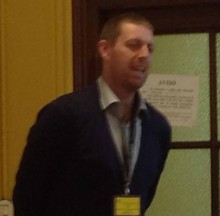Thom Kiddle on designing digital materials

Thom Kiddle opened his presentation with statistics pertaining to the digital revolution, and the fact that teachers need to take control of issues relating to digital language teaching. His suggestion was that we can and should forge a principled pathway through the myriad of materials coming our way from so many different directions and dimensions, and that we do this based on our professional expertise. Given the inevitability of technological change, we should take the bull by the horns and really think out how to maximise the potential of the new tech, rather than trail behind reluctantly. In other words, we should be investigating how we can devise language teaching materials and tools which exploit the emergent potential of digital delivery modes.
He then talked us through a selection of 10 features of current digital delivery modes to illustrate ways in which the digital format can go beyond what's possible on paper. These were:
- the infinite canvas - eg with prezi, the virtual canvas extends infinitely in all directions
- scrolling - you can make a vertical storyboard that extends down for ever - like a virtual toilet roll!
- touchscreen interaction - so intuitive that many children are stumped when a screen turns out not to be interactive
- hyperlinked content curation and choice over time and type of access - and especially QR codes, which can provide a bridge between the physical world through a smart phone into the virtual world
- embedded multimedia - students can share their own vids, pics, enthusiasms
- multimodal interaction - eg vids with peer commentary space
- adaptive pathways - eg tests which self-adapt to the level of the student
- layering and augmented reality - eg images which change as the cursor rolls over them
- collaborative learning - the idea of learners from different places connecting up online
- learner analytics and digital memory - automated progress tracking and the like
This list was very usefully specific for tech-novices like me, providing the vocabulary I'd need to research these features further.Acknowledging that all that glitters isn’t gold, and that educational technology can be misused, Thom referenced the work of Twiner et al (Twiner 2010) in which a principled framework for the use of technology and pedagogy is presented and might be built upon.
Thom's talk clearly belongs in the South East corner of our map of ELT.




Add new comment